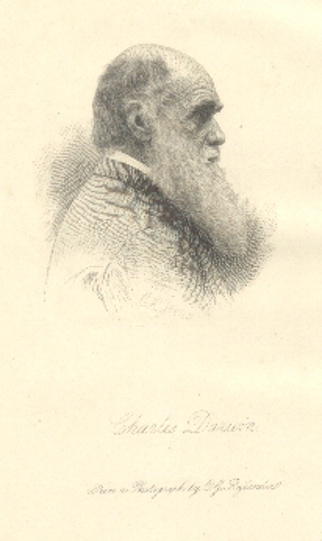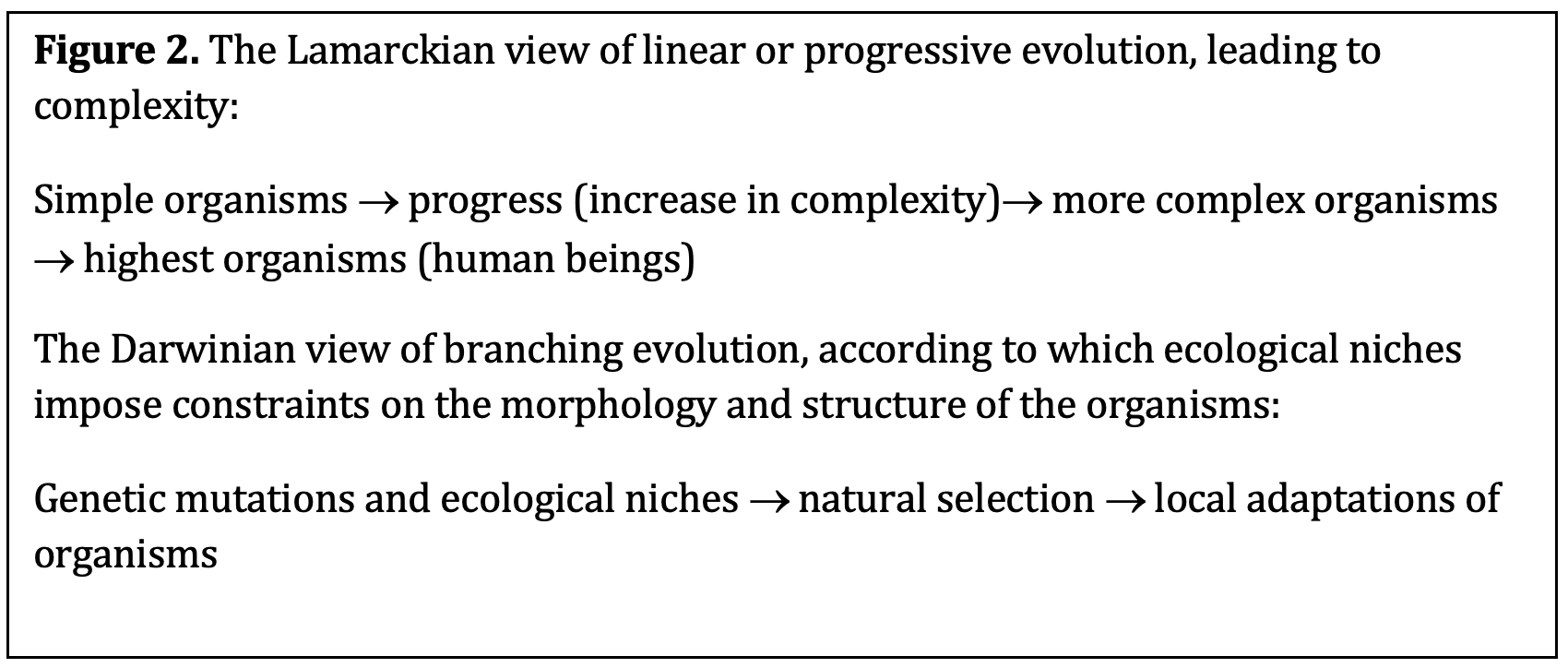Friedel Weinert
Contrary to common belief, Charles Darwin (1809–1882) (fig. 1) is not the father of evolutionary theory. The fact of evolution was recognized by earlier researchers, who also searched for explanations. But it was Charles Darwin who proposed a viable explanation of evolution in his book On the Origin of Species by Means of Natural Selection, or the Preservation of Favoured Races in the Struggle for Life, which was published in 1859. The full title of the book is quite revealing because it expresses in a nutshell the gist of Darwin’s ideas.

To a certain extent, however, this title is misleading. Darwin did not attempt to show how organic life arose on Earth at the dawn of time. Nor is this work concerned with races, human or non-human. It deals with evolutionary descent by the mechanism of natural selection. Although Darwin’s book is quite long, it was originally only meant to be an abstract to a fuller work on evolution that Darwin intended to write later. But Darwin was rushed into publishing his work in order to secure his priority because he had received a paper from Alfred Wallace (1823–1913), “On the Tendency of Varieties to Depart Indefinitely from the Original Type” (1858) in which Wallace presented roughly the same ideas. Receiving a copy of this paper alarmed Darwin because he had already developed his ideas about evolution by 1838, after a five-year voyage on the Beagle, which lasted from 1831–1836.There are differences between Darwin’s and Wallace’s approach: Wallace doubted Darwin’s inference from domestic to wild animals; he was more concerned with species than individuals; and, most importantly, he excluded humans from the impact of natural selection.
We should distinguish Darwin’s theory of branching evolution from earlier attempts, such as Jean Baptiste Lamarck’s (1744–1829) theory of linear, progressive evolution (1809). So, what is Darwin’s theory of branching evolution?
A rough sketch of the theory says that evolution is the survival of the fittest. It is interesting to note that in the first editions of Origin Darwin neither used the term “evolution” nor the phrase “survival of the fittest.” It was actually the British biologist, philosopher, and sociologist Herbert Spencer (1820–1903) who popularized Darwin’s idea of the preservation of favorable variations by the expression “survival of the fittest.”
Darwin approved of this and began to use the phrase “natural selection or survival of the fittest” from the fifth edition onward (it appears in the introduction to chapter four). The association has survived in the popular mind: many think of evolution as some progress toward higher forms of life, but his thinking is more Lamarckian than Darwinian (fig. 2).
What did Darwin really say? First, instead of evolution Darwin speaks of his theory of descent with modification. At the end of the nineteenth century “evolution” had a technical meaning in embryology: it was thought that embryos grew from preformed homunculi (or miniature human beings) enclosed in the egg or sperm. The term also stood for progress of developing forms from a rudimentary to a mature or complex state. Second, when Darwin speaks of natural selection he means the preservation of favorable variations, that is, if keeping a characteristic organic feature is favorable in a particular environment for survival and procreation then it tends to be preserved. Natural selection is therefore a statistical principle: it explains what is likely to happen to organisms in a changing environment.
Darwin avoided the term evolution in the sense of progress because he did not think that the development of species could be understood as a progress from lower to higher forms. For Darwin, evolution just meant a better adaptation of organisms to their respective environments. Darwin therefore rejected Lamarck’s progressive modification and replaced it by gradual modification. So, instead of saying that species tend toward some kind of perfection—for instance they get more and more complex—Darwin’s idea was that organic change leads to local adaptations in a changing environment. In this sense, an organism can, for instance, lose the function of its sight if it adapts to living in dark caves. So, the fittest are not the best in an absolute sense but are simply organisms with the most adequate adaptation to environmental niches. For instance, there are 200 species of cichlids in Lake Tanganyika in Africa, which are often separated by just a few hundred meters. Many of these species exist nowhere else in the world.
So far, we have concentrated on species as populations of organisms. Here evolution means that local adaptations to a changing environment results in greater diversification of species, such as in Lake Tanganyika. The more species diversify, the more ecological niches are filled with organisms. This is what Darwin means by descent with modification.
But let us now leave the bird’s-eye view and descend to the level of the individual within a species. How does evolution look from this point of view? Is it only the fittest that survive? Recall that Darwin at first spoke of the preservation of favorable variations in individuals, rather than survival of the fittest. Later, the term “the fittest” was not employed as an absolute term but had to be understood relative to a local environment. From an individual’s point of view, to be fit means to be well-adapted to a particular niche.
So how does the individual survive in a given environment? Darwin starts from the idea of a struggle for survival: any given environment can only support a limited number of individuals of a species. There are always many more individuals born than can survive, due to food shortages. Darwin followed Malthus in holding that offspring are born exponentially but food resources only grow arithmetically. In a given environment, individuals with a slight advantage over others have a better chance of surviving and procreating. Individuals with variations that are the most injurious would tend to be eliminated. This is the principle of natural selection: preservation of favorable variations and rejection of injurious variations.
And all adaptations and variations follow from the struggle for life: not only the survival of the individual, but success in leaving progeny (fig. 3).
We can now ask: what causes these variations in individuals? Today, biology can provide the answer: it is due to genetic changes. Biology also distinguishes three levels of variations:
- Species are the unit of evolution (descent with modification);
- Individual organisms are the unit of natural selection (the preservation of favorable characteristics); and
- Genes are the units of variation in individuals.
But Darwin did not know about genes, which were a much later discovery. Nor did he know of the work of the Austrian monk Gregor Mendel (1822–1884), who discovered the basic principles of heredity through his experiments on garden peas. Mendel’s work was published in 1866 but remained dormant until its rediscovery at the beginning of the twentieth century. Darwin often spoke of our ignorance of the cause of each particular variation in individuals. Without knowledge of Mendel’s genetic discoveries, he suspected that “disturbances in the reproductive system,” as he put it, chiefly contributed to the varying or plastic condition of the offspring.[1]What about human beings?
There is only one sentence in Origin where Darwin mentions humans: “Light will be thrown on the origin of man and his history.”[2]
Only twelve years after the publication of Origin did he tackle the question of human origins in a book entitled The Descent of Man, and Selection in Relation to Sex (1871), but again, the emphasis is on descent rather than origins.
Unlike Wallace, Darwin did not make an exception for humankind. Because of his change of perspective from progressive to branching evolution, he admitted humans into the natural order. Humans evolved from ape-like creatures through branching evolution. The human brain is as much a product of evolution as any other organ. With Darwin’s theory, the traditional world of design passed away. That is, the natural world was no longer seen as the deliberate design of a divine engineer.
Darwin’s theory of evolution met with a great deal of resistance, which was partly motivated by religious sensitivities. People believed that evolution had no purpose because it does not strive for perfection; individuals just seek to ensure their own survival and increase their gene representation. Additionally, they believed that evolution has no direction: its aim is not the birth of humankind and organisms only become better adapted to their local environments.[3]Darwin’s materialism also disturbed his contemporaries: the evolution of all living organisms is to be explained by appeal to biological mechanisms, like natural selection, not divine intervention. Unlike Lamarck, who held that the emergence of humankind was a necessary consequence of evolution, Darwin rejected such biological determinism. He thought that evolution was contingent, meaning that it depended on many random factors.
Darwin also faced scientific objections. One problem was the paucity of fossil evidence. Darwin’s theory assumes that evolution is gradual and imperceptibly slow. This gradualness should be observable in the fossil record: there should be intermediate forms between, say, ancient dinosaurs and modern birds (Archaeopteryx). Such fossils were eventually discovered (the Archaeopteryx in 1861) but as their scientific impact was not obvious, the snail-paced march of evolution could be doubted.
Another problem for Darwin’s theory was the age of the Earth. At Darwin’s time William Thomson, Lord Kelvin (1824–1907), estimated the age of the Earth to be around 100 million years. Even this time span was not sufficient for the slow and gradual evolution of species, which Darwin envisaged in his theory. Darwin died before newer estimates demonstrated that both the Earth and the universe were billions of years old. Such calculations required new techniques that only became available as the nineteenth century drew to a close. In 1902 a breakthrough occurred when Ernest Rutherford (1871–1937) and Frederick Soddy (1877–1956) formulated the decay law. The decay law shows how the number of radioactive nuclei in a given sample of radioactive material decreases (exponentially) with time. The half-life of the decay is the time it takes for the activity to be reduced by half. The decay law gave rise to radioactive dating, a method of providing information about the age of rocks and fossilized life forms.
Further reading:
Coyne, Jerry A. Why Evolution Is True. Oxford: Oxford University Press, 2009.
Darwin, Charles. On the Origin of Species by Means of Natural Selection, or the Preservation of Favoured Races in the Struggle for Life. London: John Murray, 1859; See also Darwin Online.
Darwin, Charles. The Descent of Man, and Selection in Relation to Sex. London: John Murray, 1871. See also Darwin Online.
Desmond, Adrian, and James Moore. Darwin’s Sacred Cause: Race, Slavery and the Quest for Human Origins. New York: Houghton Mifflin Harcourt, 2009.
Gould, Stephen Jay. Ever Since Darwin: Reflections on Natural History. New York: Penguin Books, 1980.
Mayr, Ernst. What Evolution Is. New York: Basic Books, 2001.
Lane, Nick. Life Ascending: The Ten Great Inventions of Evolution. London: Profile Books, 2010.
Ridley, Mark. Evolution. Oxford: Oxford University Press, 1997.
Ruse, Michael. Darwin and Design: Does Evolution Have a Purpose? Cambridge, MA: Harvard University Press, 2003.
“The Evolution of Evolution,” Scientific American, January 2009. https://www.scientificamerican.com/magazine/sa/2009/01-01/
Weinert, Friedel. Copernicus, Darwin & Freud: Revolutions in the History and Philosophy of Science. Chichester, UK: Wiley–Blackwell, 2009.
Endnotes
[1]. Charles Darwin, On the Origin of Species by Means of Natural Selection, or the Preservation of Favoured Races in the Struggle for Life (London: John Murray, 1859), 131–2.
[2]. Darwin, On the Origin of Species, 488. Compare this with Adrian Desmond and James Moore, Darwin’s Sacred Cause: Race, Slavery and the Quest for Human Origins (New York: Houghton Mifflin Harcourt, 2009).
[3]. Stephen Jay Gould, Ever Since Darwin: Reflections on Natural History (New York: Penguin Books, 1980), 12–13; and Darwin, On the Origin of Species, 201.



